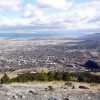Anyone who hasn’t done it thinks being in a touring rock band is one big party. A sweet ride through endless excitement in exotic locales. In reality, it’s a punishing existence of missed sleep, bad food, and very little money. Oh, and driving. Lots and lots of driving.
How do I know this? Because I did it for much of the ’80s and ’90s, as both lead singer of New York’s Chrome Cranks and as a road manager. And, due to those never-ending itineraries of lengthy hauls from one smelly club to the next, I didn’t get to stop much. Most of what I saw flew by at 65 mph (okay, maybe 75), as I squinted through the dirty glass of the cramped, stinking vans I lived in for weeks at a time. After two or three such weeks, driving through the Midwest and Plains states, the view gets to be rather…uninspiring.
But then there’s Montana.
Lunar-landscape rock formations. Low, rippling, carpets of grass so thick and green you have to fight back the urge to throw off your shoes and run ‘til you collapse. Up above, 360 degrees of impossibly high mountains, capped with jagged, neck-snapping peaks. And don’t forget Glacier and Yellowstone national parks, swarming with watchable wildlife, lush forests, extraterrestrial geysers, and those bubbling, boiling geothermal pools.
Or that Big Sky. They weren’t kidding when they called it that—boundless, cloudless, sparkling blue, it absolutely crushes everything, massive mountains included. No, the world isn’t upside down, but a visit to the Treasure State sure puts this whole surface-of-the-Earth concept in its place. Indeed, to stand beneath the arid Montana firmament is to be nowhere but under the very eye of the Universe itself.
So now that I’m a married man and life has slowed to a more manageable cant, my love and I get to visit this most beautiful chunk of the Lower 48. And this time I get to go as a human being, not a rock n’ roll musician.
If you’re a winter sports nut, you’ll no doubt be in heaven, as Montana is home to dozens of ski resorts, famous for their short lift lines due to the region’s considerable distance from both coasts. During the warmer months—May through September, when we’re visiting—outdoorsy types head in for camping, hunting, and the world-renowned fly fishing. But as a pair of non-predators unwise in the ways of the pup tent and the fly reel, we’ve opted for a rented-lodgings/open-road plan.
Coming from the east, most airlines don’t fly direct. We hit a connecting flight in Minneapolis that puts us into Billings at about 10pm Mountain Time. Warm, dry, pure air: this place is one big exhale, washing over us as we step out of the terminal. As with other Western states, Montana’s cities came of age during the late 19th and early 20th centuries. Thus, its larger towns are typically endowed with stately restored railroad hotels and charming Victorians reborn as bed and breakfast inns. After spending most of our day in in-flight hell, the Josephine Bed and Breakfast is a warming beacon of comfort. Built in 1912 by a wealthy rancher, the home became a women’s boarding house and secretarial school in the 1930s. After being shuttered for decades, it reopened as a B&B in 1992. Clean and cozy, the Josephine’s convenient downtown location is five easy minutes by rent-a-car from Billings International Airport. Owners Harvey and Bobbi Bybee are among the sweetest, gentlest folks we’ve met, even letting us sleep in well past checkout, after the airline food comes back to bite us during the night.
At Harvey’s recommendation, we set out for Red Lodge, about 70 miles southeast of Billings. A ski town at the northern edge of the Beartooth mountain range, the spot slows down in the off-season but is still home to enough smart shops and eateries to make it worth the drive. Constructed between 1880 and 1915, this former coal-mining community boasts a number of historic Wild West-era buildings, as well as the Beartooth Nature Center, a nonprofit preserve with over 100 rescued wild animals. This rare opportunity to watch bear, mountain lions, bobcat, wolves, and other beautiful species so closely should not be missed, especially by those with children in tow. After making new four-legged friends, we head three hours west, to Bozeman.
In many ways, Bozeman, home to Montana State University, is like many other college towns: bookstores, restored movie theaters, hip student hangouts. But few academic locales can match this town’s strong mix of buzzing undergraduate activity, a vibrant arts scene, and the undeniably Western character that city founder John Bozeman brought here in the 1860s. Make no mistake, Bozeman’s students and faculty are here as much for the breathtaking beauty of the four surrounding mountain ranges as for their own intellectual growth. The town’s thriving outdoor sporting equipment businesses certainly bear this out.
All of this is what drew former Yellowstone rangers Chris Nixon and Jon Gerster to Bozeman in 1996, when they purchased the crown jewel of Montana B&Bs, the magnificent Lehrkind Mansion. Built by brewer Julius Lehrkind in 1897, this grand brick Queen Anne Victorian—a short walk from the downtown and a quick drive from the wondrous Museum of the Rockies—offers striking views and regal comfort. Going to great lengths to summon this impeccably maintained home’s bygone spirits, Chris and Jon have filled each of its four guest suites with period antiques; a monolithic, turn-of-the-century music box commands the book-filled study, while working Victrolas and Gramophones are perched around the velvet-lined parlor. A true trip through the tunnel of time, the Lehrkind brings back the best of Victoriana—without the constricting corsets and murderous shoes.
Of course, no Montana outing is complete without a visit to Yellowstone National Park. So, after two wonderful days in Bozeman, we drive 90 gorgeous miles south to the town of West Yellowstone, adjacent to the Wyoming border and the middle of the park’s western entrance. We’ve tapped this as our “budget night,” opting for the friendly, mid-priced City Center Motel. Park dictum says you need a good five days to really see enough of Yellowstone, and, given its 3,472 square miles of raw wilderness, that’s quite believable. Unfortunately, we only have one-and-a-half. Nevertheless, we manage to cram in a lot, touring surreal, fumarole-wafting hot springs with names like Fountain Paint Pot and Biscuit Basin; glimpsing the hulking elk who sit so stoically by the roadside; and, yes, catching an eruption of the not-at-all-disappointing geyser, Old Faithful.
Outside of those at Yellowstone, many of the region’s geothermal sites are non-sulfuric and temperate, long known to Native Americans for their healthful, healing properties. As we drive north on I-89, we stop at one, Chico Hot Springs Resort, in the tiny town of Pray. A popular rest station among early settlers, the spot is a rustic, clapboard complex with a large hotel, gourmet restaurant, poolside saloon, even horseback riding, and counts Hollywooders like Peter Fonda and Dennis Quaid among its frequent visitors. After a quick soak in the prime-time-populated pool, we grab a bite and head an hour north to Livingston.
Perhaps the quintessential Montana railroad town, Livingston was founded by the Northern Pacific line in 1882. The city’s twin altars to the Age of Steam are its beautiful 1902 train depot, now a museum, and, directly across the street, the glorious Murray Hotel. With both a café and a too-cool, jet-age bar, this 100-room monument of 19th Century railway elegance has hosted humorist Will Rogers, who once tried to sneak a horse in via the hand-cranked elevator, and Hollywood director Sam Peckinpah, who lived in one of its sprawling suites. Recently, Livingston has seen a steady rebirth, adding to its growing community of artists, filmmakers, and writers.
After an outstanding repast at nearby Chatham’s Livingston Bar & Grill, on a site said to have been Calamity Jane’s favorite local watering hole, we stroll through the town’s historic blocks. To the west, just above the spiky heights of the Absarokas, the deep orange dusk closes in on our final night under the Big Sky.
Sure beats a smelly van.








